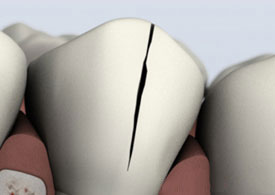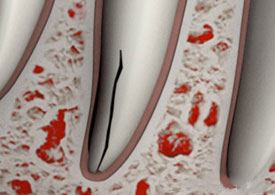More treatment
TRAUMATIC

More Treatment
Cracked teeth
The cracked tooth presents with a variety of symptoms, which can include erratic pain when chewing, pain on release of biting, or pain when your tooth is exposed to extreme temperatures. The pain may come and go and there may be difficulty in locating which tooth is causing the discomfort. The treatment and outcome for your cracked tooth depends upon the type, location and extent of the crack.
TYPES OF CRACKS

Craze lines
These are tiny cracks that only affect the outer enamel of the tooth. These cracks are more common in adults. These types of cracks are superficial and are usually of no concern.

Fractured Cusp
When a cusp becomes weakened, a fracture may result. The cusp may break off or be removed by Dr. Hassan. A fractured cusp sometimes damages the pulp; therefore, root canal maybe necessary. Your dentist will usually restore the tooth with a full crown.

Treatable Cracked Tooth
This type of crack extends from the chewing surface of the tooth and vertically migrates towards the root. In some cases, the crack may extend below the gum line. It is possible for the crack to extend further into the root. Damage to the pulp is commonplace. In this case, root canal treatment is usually necessary. A cracked tooth that is not treated will worsen, resulting in the loss of the tooth. Therefore, early detection is essential.

Split Tooth
A split tooth is usually the result of an untreated cracked tooth. It can be identified by a crack with distinct segments. This type of tooth can never be saved intact. Yet, the position and extent of the problem will dictate whether any portion of the tooth can be saved. Sometimes, endodontic treatment by Dr. Hassan and restoration by your dentist can be used to save a portion of the tooth.

Vertical Root Fracture
A vertical root fracture begins at the root and extends towards the chewing surface of the tooth. Unfortunately, they show minimal symptoms and may go unnoticed. Treatment involves endodontic surgery if a portion of the tooth can be saved by removal of the fractured root. Otherwise, the tooth will have to be extracted.
Root Resorption
Root resorption is the breakdown and loss of the root structure of a tooth. This occurs when living body cells attack part of the tooth. Deciduous root resorption is a natural process which allows exfoliation of the primary teeth to make way for the secondary (adult) teeth. In deciduous teeth, pressure is exerted by the erupting secondary teeth. Root resorption of secondary teeth can be caused by trauma, inflammation, aggressive tumors and growth, among other things. Severe root resorption can be difficult to treat and may require extraction of teeth, but cases can often be further examined with cone beam 3D technology to determine the best course of treatment.
Regenerative Endodontics
Regenerative endodontics is one of the most exciting developments in dentistry today and endodontists are at the forefront of this cutting-edge research. Regeneration uses the concept of tissue engineering to restore the root canals to a healthy state, allowing for continued development of the root and surrounding tissue in an immature tooth.
Endodontists’ knowledge in the fields of pulp biology, dental trauma and tissue engineering can be applied to deliver biologically based regenerative endodontic treatment of necrotic immature permanent teeth resulting in continued root development, increased thickness in the dentinal walls and apical closure. These developments in regeneration of a functional pulp-dentin complex have a promising impact on efforts to retain the natural dentition, the ultimate goal of endodontic treatment. Our office continues to remain at the forefront of endodontic care and is one of the few endodontic practices that is able to provide this treatment option to our young patients.
Internal Bleaching
Internal Bleaching (intracoronal bleaching) is a technique used to whiten the appearance of teeth and is different than over-the-counter solutions used to whiten teeth (extracoronal bleaching). Internal bleaching is conducted by Dr. Hassan and can only be performed after successful root canal therapy.
Pulpotomy
The blood vessels, nerves, and tissue that keep a tooth healthy and alive are located in the tooth’s pulp, which is protected by the outer enamel and tooth structure. Sometimes the pulp can become infected or inflamed. The infected or inflamed pulp can be removed with a pulpotomy. A medicated dressing is then placed in the tooth chamber to prevent further infection and to promote the healing of the remaining pulp. The chamber is then sealed. Because this procedure is often performed on deciduous (baby) teeth, it is sometimes referred to as a baby root canal.
CBCT (3D imaging)
CBCT technology is able to take a limited field scan of the tooth in high quality 3D images. The 3D image allows us to rotate the tooth in 360 degrees along any axis. This allows us to achieve more accurate diagnoses with more predictable treatment outcomes. It can help confirm or dismiss the need for endodontic treatment. This technology is safe and it quickly becoming the new standard in Endodontic treatment.













